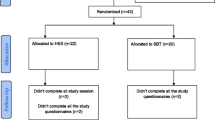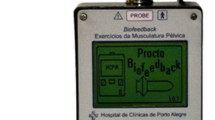Abstract
PURPOSE: The aim of this study was to examine the long-term results of electromyographic biofeedback training in fecal incontinence. METHODS: Thirty-seven patients (1 male) received a customised program of 2 to 11 (median, 3) biofeedback training sessions with an anal plug electromyometer. Nine patients had persistent incontinence after anal sphincter repair, a further 8 patients had postsurgical or partial obstetric damage of the sphincter but no sphincter repair, 9 patients had neurogenic sphincter damage, and 11 patients were classified as having idiopathic fecal incontinence. Duration of voluntary sphincter contraction was measured by anal electromyography (endurance score) before and after treatment. A postal questionnaire was used to investigate the following variables: 1) subjective rating on a four-grade Likert-scale of the overall result of the biofeedback training; 2) incontinence score (maximum score is 18, and 0 indicates no incontinence); and 3) rating of bowel dissatisfaction using a visual analog scale (0 to 10). RESULTS: Twenty-two patients (60 percent) rated the result as very good (n=8) or good (n=14) immediately after the treatment period. Median endurance score improved from 1 to 2 minutes (P<0.0001). Median incontinence score improved from 11 to 7, and bowel dissatisfaction rating improved from 5 to 2.8 (bothP<0.0001). After a median follow-up of 44 (range, 12–59) months, 15 patients (41 percent) still rated the overall result as very good (n=3) or good (n=12). The incontinence score did not change during follow-up. Median bowel dissatisfaction rating deteriorated from 2.8 to 4.2 but remained better than before treatment. Poor early subjective rating and the need for more than three biofeedback sessions were predictive of worsening during follow-up. CONCLUSION: We think it is encouraging that in this study biofeedback treatment for fecal incontinence with an intra-anal plug electrode resulted in a long-term success rate in nearly one-half of the patients.
Similar content being viewed by others
References
Sangwan YP, Coller JA, Barrett RC, Roberts PL, Murray JJ, Schoetz DJ Jr. Can manometric parameters predict response to biofeedback therapy in fecal incontinence? Dis Colon Rectum 1995;38:1021–5.
Hallböök O, Sjödahl R. Pressure area in anorectal manometry. Eur J Surg 1995;161:603–6.
Bartram CI, Burnett SJ. Atlas of anal endosonography. 1st ed. Oxford: Butterworth-Heinemann, 1991.
Cheong DM, Vaccaro CA, Salanga VD, Wexner SD, Phillips RC, Hanson MR. Electrodiagnostic evaluation of fecal incontinence. Muscle Nerve 1995;18:612–9.
Rogers J, Henry MM, Misiewiez JJ. Disposable pudendal nerve stimulator: evaluation of the standard instrument and new device. Gut 1988;29:1131–3.
Miller R, Bartolo DC, Locke-Edmunds JC, Mortensen NJ. Prospective study of conservative and operative treatment for faecal incontinence. Br J Surg 1988;75:101–105.
MacLeod JH. Management of anal continence by biofeedback. Gastroenterology 1987;93:291–4.
Rieger NA, Wattchow DA, Sarre RG,et al. Prospective trial of pelvic floor retraining in patients with fecal incontinence. Dis Colon Rectum 1997;40:821–6.
van Tets WF, Kuijpers JH, Bleijenberg G. Biofeedback treatment is ineffective in neurogenic fecal incontinence. Dis Colon Rectum 1996;39:992–4.
Patankar SK, Ferrara A, Levy JR, Larach SW, Williamson PR, Perozo SE. Biofeedback in colorectal practice: a multicenter, statewide, three-year experience. Dis Colon Rectum 1997;40:827–1.
Patankar SK, Ferrara A, Larach SE,et al. Electromyographic assessment of biofeedback training for fecal incontinence and chronic constipation. Dis Colon Rectum 1997;40:907–1.
Keck JO, Staniunas RJ, Coller JA,et al. Biofeedback training is useful in fecal incontinence but disappointing in constipation. Dis Colon Rectum 1994;37:1271–6.
Enck P, Däublin G, Lübke HJ, Strohmeyer G. Long-term efficacy of biofeedback training for fecal incontinence. Dis Colon Rectum 1994;37:997–1001.
Enck P. Biofeedback training in disordered defecation: a critical review. Dig Dis Sci 1993;38:1953–60.
Engel BT, Nikoomanesh P, Schuster MM. Operant conditioning of rectosphincteric responses in the treatment of fecal incontinence. N Engl J Med 1974;290:646–9.
Chiarioni G, Scattolini C, Bonfante F, Vantini I. Liquid stool incontinence with severe urgency: anorectal function and effective biofeedback treatment. Gut 1993;34:1576–80.
Guillemot F, Bouche B, Gower-Rousseau C,et al. Biofeedback for the treatment of fecal incontinence: long-term clinical results. Dis Colon Rectum 1995;38:393–7.
Whitehead WE, Burgio KL, Engel BT. Biofeedback treatment of fecal incontinence in geriatric patients. J Am Geriatr Soc 1985;33:320–4.
Miner PB, Donnelly TC, Read NW. Investigation of the mode of action of biofeedback in treatment of fecal incontinence. Dig Dis Sci 1990;35:1291–8.
Buser WD, Miner PB. Delayed rectal sensation with fecal incontinence. Successful treatment using anorectal manometry. Gastroenterology 1986;91:1186–91.
Wald A. Biofeedback therapy for fecal incontinence. Ann Intern Med 1981;95:146–9.
Rao SS, Welcher KD, Happel J. Can biofeedback therapy improve anorectal function in fecal incontinence? Am J Gastroenterol 1996;91:2360–6.
Glia A, Gylin M, Åkerlund JE, Lindfors U, Lindberg G. Biofeedback training in patients with fecal incontinence. Dis Colon Rectum 1998;41:359–64.
Swash M. Histopathology of pelvic floor muscles in pelvic floor disorders. In: Henry MM, Swash M, eds. Coloproctology and the pelvic floor. 2nd ed. Oxford: Butterworth-Heinemann, 1992:173–83.
Author information
Authors and Affiliations
About this article
Cite this article
Ryn, AK., Morren, G.L., Hallböök, O. et al. Long-term results of electromyographic biofeedback training for fecal incontinence. Dis Colon Rectum 43, 1262–1266 (2000). https://doi.org/10.1007/BF02237433
Issue Date:
DOI: https://doi.org/10.1007/BF02237433




